Laing Recipe
Laing (or Natong) is a spicy dish that is Coconut milk (or cream) based with dried taro leaves. This originated from the Philippine’s Bicol region (south most part of Luzon island). Because of its really great taste and budget friendly cost, this dish became well known. Spicy, nutty, and creamy –– these are generally some…
This post may contain affiliate links. Please read our disclosure policy.
Laing (or Natong) is a spicy dish that is Coconut milk (or cream) based with dried taro leaves. This originated from the Philippine’s Bicol region (south most part of Luzon island). Because of its really great taste and budget friendly cost, this dish became well known.
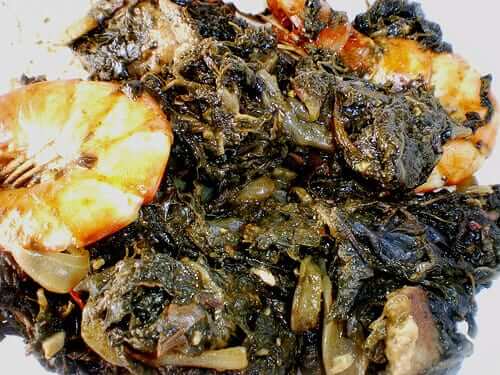
Spicy, nutty, and creamy –– these are generally some of the adjectives we use to describe Bicolano cuisine as a whole. At its best, the Bicolanos have come up with dishes like Bicol Express, Sinantol, and the Pili Roll, among others. Well known for being spice lovers, as well as innovative with their use of coconuts, their cuisine is nothing short of a national treasure. And what better example of this vast and flavorful cuisine than the ever popular, ever delicious laing?
Taro leaves, shrimp paste, pork, and gata come together for this dish that’s a perfect balance of sweet and savory. While the Bicolanos refer to it as pinangat, this local stew has become a Filipino favorite across the country! Its green exterior catches one’s eye when it makes an appearance at the dining table. But that’s not all that makes this dish stand out –– one bite and you’ll see why everyone across the country has gone absolutely crazy for this refreshing bite!
Going nuts for coconuts
As we mentioned before, Bicolanos love themselves a dash of coconut milk or gata in almost anything they make. We can classify laing under an array of dishes we call ginataan. Quite literally, this means that these kinds of dishes are cooked in a generous amount of coconut milk. Gata’s sweet, creamy taste sets it apart as an ingredient in Filipino cuisine. Its nutty fragrance makes your dishes more aromatic, so not only do they taste great –– but they smell amazing, too! And laing is no exception.
Even other Filipino classics, other than the ones conceptualized in the Bicol Region, make use of this delightful ingredient. For instance, Chicken Kare-kare sa Gata is a great way of combining two things FIlipinos love: kare-kare and coconut milk! The creaminess of the gata pairs perfectly with the rich flavors we love so much in kare-kare.
Coconut milk is also wonderful in adobo! Rich, creamy, and oh so flavorful, adobong manok sa gata may be one of my favorite renditions of adobo yet! By taking a classic dish like adobo and adding gata, you’re able to practically create a new dish entirely –– one everyone will enjoy! This is especially delicious when you have steaming white rice to fully absorb the nutty and fantastic flavors.
Laing, adobong manok sa gata, and chicken kare-kare sa gata are just some of the many ingredients coconut milk graces its presence with. But not only does this taste incredible –– it’s also super nutritious! Coconut milk is packed with an assortment of vitamins and nutrients, with health properties that will keep your body healthy and strong. It’s more than just for satisfying your stomach!
For one, coconut milk is incredibly rich in antioxidants. Its high amounts of vitamin C and E help neutralize harmful substances that might corrupt your body. These are also important in keeping your immune system strong and healthy, so it may effectively fight against diseases.
Gata is also rich in electrolytes! If you don’t know what these are, you can commonly find electrolytes in sports drinks, like Gatorade. What these are able to do is keep your system hydrated, as well as control your nervous-system functions and regulate muscle contractions. Electrolytes battle fatigue and low energy, and are also important in balancing your body’s pH levels, which means that it prevents acid reflux and other related diseases. In dishes like laing, then, not only are you getting a filling meal –– you’re getting an energy boost, too!
Lastly, did you know that gata aids in weight loss? Coconut milk’s properties translate more into energy than they do in fatty acids. By assisting in keeping your metabolism working at optimal speed, you’re able to enjoy laing and other dishes with a slightly less guilty mindset!
With the amount of health benefits and properties stored in coconut milk, it’s no wonder why this creamy substance is so beloved around the country. Apart from laing, what’s your favorite gata dish?
Tips for Cooking Laing
Admittedly, it may be daunting to cook the classic laing for the first time. However, here are a few tips and tricks that are handy to have up your sleeve! These will hopefully help in making your laing cooking experience that much easier.
Too hot to handle? Control your spice!
Bicol cuisine and spicy food are a match made in heaven. But when the heat can get too much, a scrumptious dish is useless if you can’t even stomach one bite! If you or your loved ones aren’t too keen on spicy food, the levels of intensity of laing are easily adaptable. While we’re using 6 pieces of Thai chili for this recipe, you’re free to remove (or if you’re brave enough, add!) as many chilies as you wish. This will help adjust your laing when it gets too hot to handle. Another option is scraping off the veins and seeds of said chili before adding it into the recipe, as it’s this that truly gives a chili its sizzle and burn! You can also add it last, after the pork, so that the rest of your laing won’t be able to fully absorb that heat.
Speaking of chili –– I use Thai or bird’s eye, but you can use any kind you prefer, too! Siling labuyo is also a popular option for this classic, heat-filled dish.
How to get rid of the laing or taro itch
Sometimes, laing can leave a slightly unpleasant, itchy sensation in your mouth. This is due to the main ingredient of this dish: taro leaves, or gabi. Gabi’s high calcium oxalate amounts are said to be the culprit behind this burning feeling.
In these types of situations, the best thing to do is ensure that you’ve washed and dried your taro leaves thoroughly! The first 15 to 20 minutes that the taro leaves are in the pot are the most crucial, too. During this time, refrain from stirring the pot, as this also makes it more prone to causing that itchiness after.
It’s worth noting that in the authentic and original form of this recipe, Bicolanos didn’t use shredded taro, but taro leaves in their whole form. The leaves wrapped around the other ingredients of the dish and were steamed in gata and lemongrass for a deeper flavor. Since we’re using shredded taro leaves here, it may not look like a lot at first. But don’t worry! The longer the leaves stay in the pot, the more you’ll see that you’ll have more than enough laing for everyone.
Go meatless with your laing!
The usual partner for laing is, unsurprisingly, a tender and juicy meat like pork. Bagnet and lechon kawali are commonly perfect pairs for this creamy vegetable dish. However, if you want to go the healthier route, you can opt not to use any meat at all! There are many ways you can prepare laing, whether it be with the classic pork, or with shrimp, crabs, or dried fish. These different renditions of laing have names, like Inlukuan, Linapay, and Tinumok. What is most important, however, is that you yourself get to enjoy it after! Add or reduce your meat however you like.
With these tips in mind, let’s get to cooking our lovely and fragrant laing!
How to Cook Laing
Preparing the ingredients
To start, let’s get all your ingredients together. Cut your half a pound of pork into thin strips, then do the same to your quarter cup of ginger. Chop up one medium-sized onion, and mince a tablespoons worth of garlic. Be sure to have your other ingredients on hand as well: your dried taro leaves, your shrimp paste, your coconut milk, your fish sauce, and salt and pepper to taste. Make sure to have half a pound of shrimp ready, too, if you choose to add it here.
Boil the ingredients in coconut milk
Let’s cook laing together. In a large pan, pour in 3 cups of gata and bring it to a boil. Add your garlic, onion, and ginger right after, then let that simmer for about 10 minutes. When that amount of time is up, add your pork and shrimp paste, or bagoong. Stir your mixture continuously, before adding in your Thai chili (as much or as little as you like). Let your dish simmer for another 10 minutes.
Then, add in 2 tablespoons of fish sauce, and your dried taro leaves. By now, you should let your laing simmer for 40 to 60 minutes to . As we mentioned earlier, it’s important not to stir it right away, as you don’t want that itchy feeling to surface later.
Add the shrimp and season it
When your time is up, and you decide to add in your shrimp, now would be the time to do so. After tossing your shrimps in, let your laing simmer for about 5 minutes. Otherwise, after the 20 minute mark –– your dish is finally ready.
Turn the heat off your stove and serve your laing hot. Enjoy it with crispy lechon kawali, or a rich bangus belly, and –– of course –– a cup (or two!) of warm, white rice.
Warm and comforting with a bit of a kick, this laing is sure to be a family favorite! Let us know what you thought of this quintessential Bicolano dish.
Did you make this? If you snap a photo, please be sure tag us on Instagram at @panlasangpinoy or hashtag #panlasangpinoy so we can see your creations!
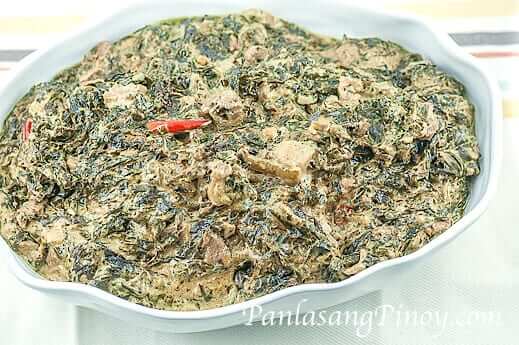
Laing Recipe
Ingredients
- 4 ounces taro leaves dried
- 1/2 lb. pork cut into thin strips
- 1/2 lb. shrimp with head (optional)
- 1/2 cup shrimp paste
- 1 onion chopped
- 6 Thai chili pepper
- 1/4 cup ginger cut into strips
- 1 tbsp garlic minced
- 4 cups coconut milk
- fish sauce and ground black pepper to taste
Instructions
- In a large pan, pour-in the coconut milk and bring to a boil4 cups coconut milk
- Add the garlic, onion, and ginger. Cook for 10 minutes1/4 cup ginger, 1 tbsp garlic, 1 onion
- Add the pork meat and shrimp paste and stir continuously1/2 cup shrimp paste, 1/2 lb. pork
- Put in the Thai chili and simmer for another 10 minutes6 Thai chili pepper
- Add the fish sauce and dried Taro leaves and simmer for 40 to 60. Add water if needed.fish sauce and ground black pepper, 4 ounces taro leaves
- Put the shrimps in and cook for for 5 minutes. Season with ground black pepper.1/2 lb. shrimp
- Serve hot. Enjoy
Video

Nutrition Information
If you loved this, then have an even bigger bite of Bicolano’s spell-bindingly spicy cuisine!
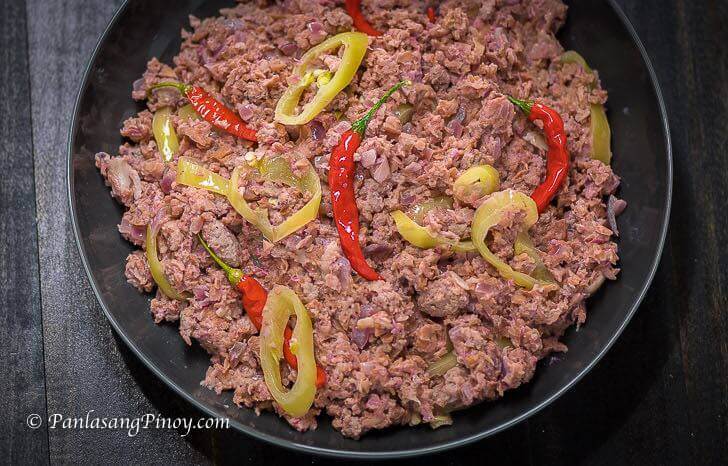
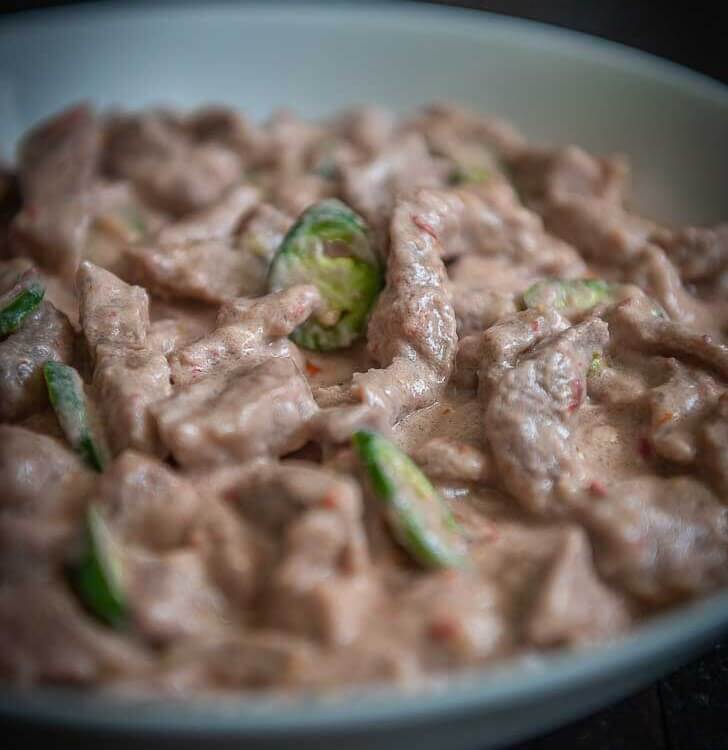
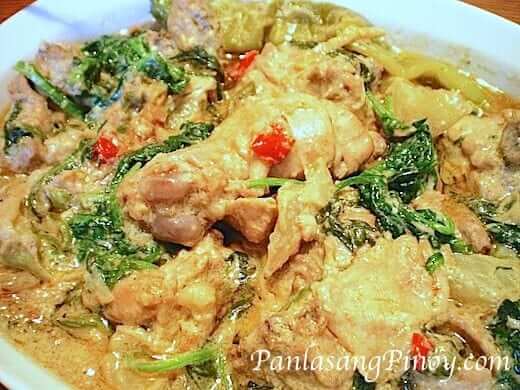
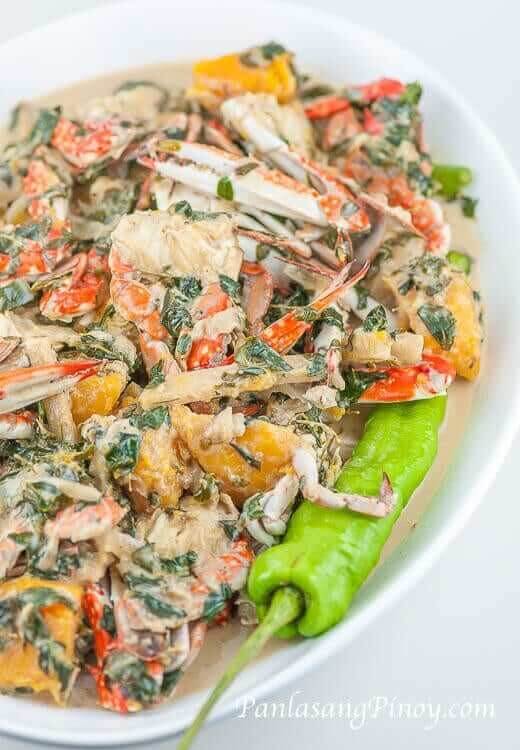
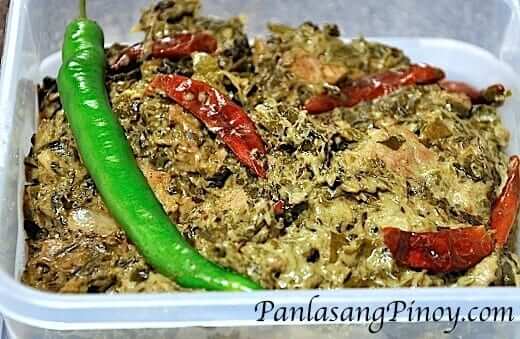

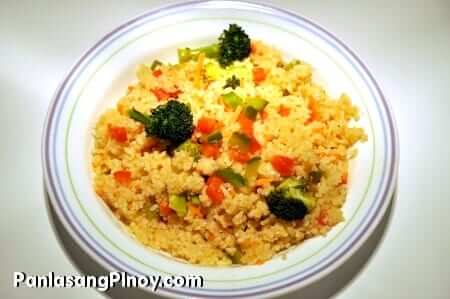
aida says
thanks for the recipe, can i use fresh taro leaves instead of dried leaves ,,how can i cook it?
Marichu says
I love Laing so much. Glad I found this vid. I’m not a good cook but after seeing this, I was amazed how easy this is. I’ll try my luck this weekend. Thanks. 🙂
Greetings from Germany.
Vanessa says
I love the taste of LAING…. Its so delicious its my new favorite
Pinky says
E di wag mong lutuin. Namintas ka pa!
liza says
about cooking the LAING…i dont agree how he cooks coz he did not wash the dried taro leaves which was we dont know where do they dry that leaves…..
Leonor says
Thanks for this. Just one question. Aside from pork,what is other alternative ? because we dont have pork here in Kuwait.
Sheryl says
i really love Laing wish someone will cook for me♥
Dora says
laing is one of my favorite dish ever…thank you for posting it..
Chelle says
i tried cooking Laing before, but the taste of dried taro leaves left me wanting. Is there a fresh alternative to the dried taro? what can possibly take its place?
thanks in advance
Terrie says
very nice one.. I loved the taste. Thanks a lot and keep uploading.. More Power!